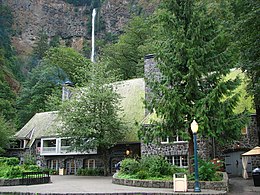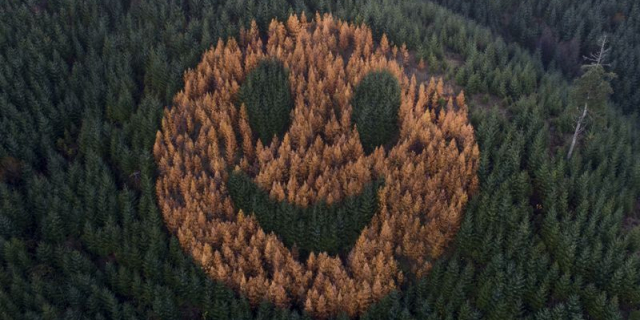Multnomah Falls is a waterfall located on Multnomah Creek in the Columbia River Gorge, east of Troutdale, between Corbett and Dodson, Oregon, United States. The waterfall is accessible from the Historic Columbia River Highway and Interstate 84. Spanning two tiers on basalt cliffs, it is the tallest waterfall in the state of Oregon at 620 ft (189 m) in height. The Multnomah Creek Bridge, built in 1914, crosses below the falls, and is listed on the National Register of Historic Places.
The land surrounding the falls was developed by Simon Benson in the early-twentieth century, with a pathway, viewing bridge, and adjacent lodge being constructed in 1925. The Multnomah Falls Lodge and the surrounding footpaths at the falls were added to the National Register of Historic Places in 1981. Contemporarily, the state of Oregon maintains a switchback trail that ascends to a talus slope 100 feet (30 m) above the falls, and descends to an observation deck that overlooks the falls...Read more
Multnomah Falls is a waterfall located on Multnomah Creek in the Columbia River Gorge, east of Troutdale, between Corbett and Dodson, Oregon, United States. The waterfall is accessible from the Historic Columbia River Highway and Interstate 84. Spanning two tiers on basalt cliffs, it is the tallest waterfall in the state of Oregon at 620 ft (189 m) in height. The Multnomah Creek Bridge, built in 1914, crosses below the falls, and is listed on the National Register of Historic Places.
The land surrounding the falls was developed by Simon Benson in the early-twentieth century, with a pathway, viewing bridge, and adjacent lodge being constructed in 1925. The Multnomah Falls Lodge and the surrounding footpaths at the falls were added to the National Register of Historic Places in 1981. Contemporarily, the state of Oregon maintains a switchback trail that ascends to a talus slope 100 feet (30 m) above the falls, and descends to an observation deck that overlooks the falls' edge. The falls attract over two million visitors each year, making it the most-visited natural recreation site in the U.S. Pacific Northwest.
The waterfall formed around 15,000 years ago[1] at the end of a hanging valley, and was created by the Missoula floods.[2][3] According to the creation story from the Multnomah tribe (from whom the falls take their name), the waterfall was formed after a young woman sacrificed herself to the Great Spirit to save Multnomah village from a plague by jumping from the cliff, and the Multnomah peoples were saved.[4] After her death, water began to flow from above the cliff, creating the waterfall.[4]
The falls were noted in the journals of explorers William Clark and Meriwether Lewis during their expedition through the Columbia River Gorge in 1805.[5] In an October 30 journal entry, Lewis notes:
passed Several places where the rocks projected into the river & have the appearance of having separated from the mountains and fallen into the river, small niches are formed in the banks below those projecting rocks which is common in this part of the river, Saw 4 Cascades caused by Small Streams falling from the mountains on the Lard.[6]
The origin of the falls' naming is unclear; scholar Lewis A. McArthur, in Oregon Geographic Names, suggested that S. G. Reed, a prominent mercantile clerk in Portland and native of Massachusetts, may have been the first to apply the name with the idea of popularizing sites along the Columbia River for steamboat excursions.[7]
Post-Reconstruction development Locationc. Bridal Veil, Oregon[8]Nearest cityCascade Locks, OregonCoordinates45°34′33″N 122°06′55″W / 45.57595°N 122.11536°WBuilt1915[8]ArchitectA.E. Doyle[9]NRHP reference No.81000512[8]Added to NRHPApril 22, 1981[8]
Locationc. Bridal Veil, Oregon[8]Nearest cityCascade Locks, OregonCoordinates45°34′33″N 122°06′55″W / 45.57595°N 122.11536°WBuilt1915[8]ArchitectA.E. Doyle[9]NRHP reference No.81000512[8]Added to NRHPApril 22, 1981[8] Visitors at the falls c. 1915
Visitors at the falls c. 1915Beginning in 1884, the Oregon Railway and Navigation Company operated a stop at Multnomah Falls on their railway, which spanned from Portland to Pasco, Washington; this stop continued to operate until World War II,[10] and included a timber bowstring truss bridge that spanned the falls at the present bridge's location.[7] Around 1891, the bridge was reinforced, but was dismantled in 1899.[7]
On January 28, 1915, Samuel C. Lancaster recommended to the Progressive Business Men's Club of Portland that a trail be built from the base of Multnomah Falls extending to the top of Larch Mountain.[7] The Club raised several hundred dollars to finance the trail, and Portland financier Simon Benson and his son Amos S. Benson pledged an additional $3,000.[7] The United States Forest Service appropriated a total of $1,500 and agreed to survey and build the trail in addition to the lookout on Larch Mountain. Benson financed Italian stonemasons to construct a bridge at the falls to allow visitor access.[11] This bridge, named the Benson Footbridge, spans the lower falls at a height of 105 feet (32 m), and provides an expansive view of the upper falls.[7]
On Labor Day 1915, Benson donated over 1,400 acres (570 ha) of land which included most of the falls as well as nearby Wahkeena Falls, to the city of Portland.[7] The Oregon Railroad and Navigation Company subsequently donated the land at the base of Multnomah Falls contingent upon their agreement that a lodge would be constructed at the site the same year.[12]
Late that year, architect A. E. Doyle, who designed Portland's Meier & Frank Building, was commissioned by the city to design the Multnomah Falls Lodge, which was completed in 1925.[9] The lodge, built in a "Cascadian" architectural style using native split fieldstone laid irregularly. The building features a steeply-pitched cedar-shingled gable roof with dormers and large chimneys.[7] In the early through the mid-twentieth century, the lodge provided both meals and lodging to travelers.[12] Contemporarily, it provides meals, a gift shop, and an interpretive center.[12] The lodge and footpaths were added to the National Register of Historic Places in 1981.[9]




































Add new comment